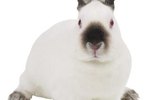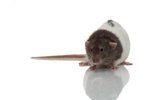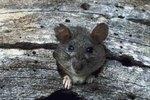
Rats use a variety of techniques to communicate with each other and their humans, with scents, sounds and body language all playing important roles. You might not notice their scents - although you might observe scent marking - and many of their vocalizations are pitched too high for humans to hear. Body language, however, is clearly visible and straightforward to interpret.
Curious Rat
Sniffing the air, standing on the hind legs or staring, or any combination of these behaviors, indicate that a rat has noticed something of interest. Some rats, especially the more nervous individuals, may slowly move their heads from side to side while staring. Eerie as this looks, it is actually just the rat equivalent of squinting. Rats don’t have good vision, and the placement of the eyes doesn’t enable good depth perception -- they're moving their heads to get a better idea of what they're looking at.
Annoyed Rat
Swishing the tail means different things depending on context. In a play fight, it denotes excitement, deepening to anger or fear in a real fight or when confronting a perceived predator. If you notice a rat doing this when approaching another pet, particularly a cat or dog, for the first time, it would be advisable to curtail the encounter immediately. Another sign of displeasure is simply pushing something, for example your hand or an unwanted snack, away with the forepaws. Puffing out the fur may indicate anger, fear or sickness.
Companionable Rat
Rats are extremely social animals, affectionate to each other and people. A rat licking you or another rat is displaying affection. When a rat is especially happy and content, he grinds his teeth, producing a soft sound. This grinding, known as bruxing, might make his body quiver and his eyes bulge in time with the jaw movements. If a rat’s eyes goggle when you pick him up or pet him, he’s not astonished to see you -- he’s delighted. Place your ear close to him to hear the bruxing.
Amorous Rat
When it comes to romantic situations, rats' body language becomes obvious. Males might occasionally run after other rats and perhaps try to mount them. But the most dramatic sign of an amorous rat comes from the girls, who tend to be more energetic in every way. When female rats go into heat, something that happens every few days, they flap their ears rapidly, often so fast they appear as a blur.
References
Photo Credits
-
Jupiterimages/Photos.com/Getty Images
Writer Bio
Judith Willson has been writing since 2009, specializing in environmental and scientific topics. She has written content for school websites and worked for a Glasgow newspaper. Willson has a Master of Arts in English from the University of Aberdeen, Scotland.




